Preservation League of New York State Continues Listing Most Endangered Places
for 2008
 ALBANY, January 4, 2008 – The Preservation League of New York State has named the Holy Trinity Monastery in Jordanville, Herkimer County, to the nonprofit group’s annual list of the Empire State’s most threatened historic resources, Seven to Save. The campus of the Holy Trinity Monastery and Cathedral encompasses 750 acres of agricultural and scenic lands with multiple structures associated with the Holy Trinity Seminary, Convent of St. Elizabeth, and three cemeteries. Founded in 1928 as a refuge against religious persecution, it is the spiritual center of the Russian Orthodox Church Abroad. From the Monastery complex, panoramic views take in Monastery landmarks and places of prayer, while beyond the property boundaries are picturesque high plains. The views to the east are particularly significant in Orthodox scripture and faith.
ALBANY, January 4, 2008 – The Preservation League of New York State has named the Holy Trinity Monastery in Jordanville, Herkimer County, to the nonprofit group’s annual list of the Empire State’s most threatened historic resources, Seven to Save. The campus of the Holy Trinity Monastery and Cathedral encompasses 750 acres of agricultural and scenic lands with multiple structures associated with the Holy Trinity Seminary, Convent of St. Elizabeth, and three cemeteries. Founded in 1928 as a refuge against religious persecution, it is the spiritual center of the Russian Orthodox Church Abroad. From the Monastery complex, panoramic views take in Monastery landmarks and places of prayer, while beyond the property boundaries are picturesque high plains. The views to the east are particularly significant in Orthodox scripture and faith.
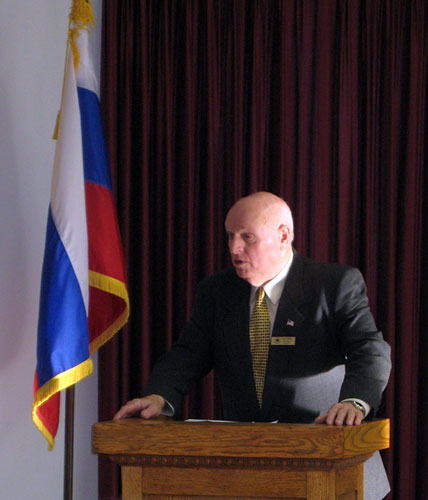 “The Holy Trinity Monastery is of extraordinary historic, religious and cultural significance, but it is currently threatened by an industrial-scale wind energy project,” said Jay DiLorenzo, President of the Preservation League. “We are here not only to call for a thorough evaluation of the project’s negative impacts on the Monastery area, but to urge the adoption of statewide siting requirements for wind energy projects. Early identification, acknowledgement and protection of historic resources consistent with state and federal environmental review processes will level the playing field and protect the special character of historic communities and sites across the state.”
“The Holy Trinity Monastery is of extraordinary historic, religious and cultural significance, but it is currently threatened by an industrial-scale wind energy project,” said Jay DiLorenzo, President of the Preservation League. “We are here not only to call for a thorough evaluation of the project’s negative impacts on the Monastery area, but to urge the adoption of statewide siting requirements for wind energy projects. Early identification, acknowledgement and protection of historic resources consistent with state and federal environmental review processes will level the playing field and protect the special character of historic communities and sites across the state.”
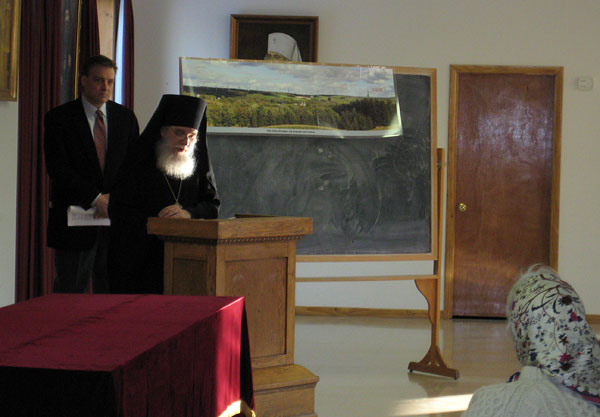 Father Luke Murianka, Deputy Abbott for the Monastery, notes that Holy Trinity Monastery is a place of immeasurable importance for the Russian Orthodox Church Abroad. “It is the residence of our first hierarch, houses our printing press, is a pilgrimage spot for believers from around the world and the final resting place of some 1,000 faithful departed, and the location of our only seminary, training men to serve the church.”
Father Luke Murianka, Deputy Abbott for the Monastery, notes that Holy Trinity Monastery is a place of immeasurable importance for the Russian Orthodox Church Abroad. “It is the residence of our first hierarch, houses our printing press, is a pilgrimage spot for believers from around the world and the final resting place of some 1,000 faithful departed, and the location of our only seminary, training men to serve the church.”
 In addition to the religious community at the Monastery, representatives of Otsego 2000 and the Mohawk Valley Heritage Corridor Commission are calling for historic preservation to be considered in the face of development pressure and insensitive public policies. “We believe the effect of the turbines upon the monastery will be devastating,” said Tania Werbizky, the League’s Regional Director of Technical and Grant Programs for western New York. “The nearly 300-foot sweep of the rotor will cause the sunlight to flicker, and the hub of the turbine will make a high-pitched whine. At night, 24 blinking red lights will fill the sky facing the monastery, and the serenity that the monks and pilgrims have long sought will be gone, quite literally, with the wind.”
In addition to the religious community at the Monastery, representatives of Otsego 2000 and the Mohawk Valley Heritage Corridor Commission are calling for historic preservation to be considered in the face of development pressure and insensitive public policies. “We believe the effect of the turbines upon the monastery will be devastating,” said Tania Werbizky, the League’s Regional Director of Technical and Grant Programs for western New York. “The nearly 300-foot sweep of the rotor will cause the sunlight to flicker, and the hub of the turbine will make a high-pitched whine. At night, 24 blinking red lights will fill the sky facing the monastery, and the serenity that the monks and pilgrims have long sought will be gone, quite literally, with the wind.”
According to Fred Miller, Executive Director of the Mohawk Valley Heritage Corridor Commission, “The Mohawk Valley is a place of magnificent history, and during the centuries-old battles for this region, churches of all denominations were the anchors for its citizens. We are especially sensitive to the preservation of the many churches throughout the Mohawk Valley – including the Holy Trinity Monastery – because they ultimately define the spirit of this place.”
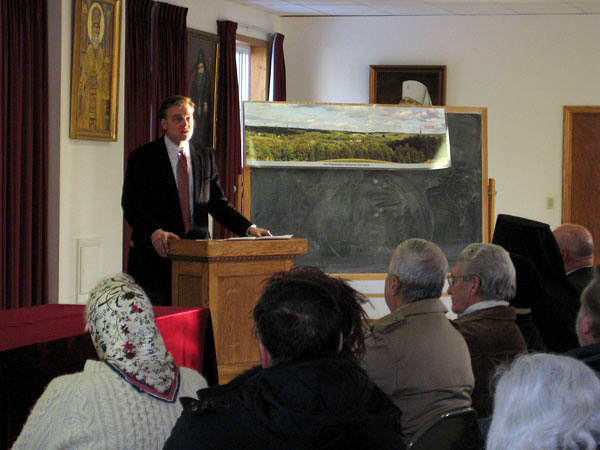 Daniel Mackay, the League’s Director of Public Policy, said the inclusion of the Holy Trinity Monastery on the Seven to Save Endangered Properties list provides the opportunity for the League to work with local advocates to protect this and other historic resources. “If New York State is to continue to make a public investment in commercial-scale wind and energy, that investment must be matched with the development of wind energy siting standards that protect the special character of historic communities and sites across the state. Further, the League believes that some locations in New York State should be off-limits to the intrusions of this industrial-scale technology. The Holy Trinity Monastery and the Glimmerglass Region are among the areas of our beautiful and historic state that should not be marred by commercial-scale wind development.”
Daniel Mackay, the League’s Director of Public Policy, said the inclusion of the Holy Trinity Monastery on the Seven to Save Endangered Properties list provides the opportunity for the League to work with local advocates to protect this and other historic resources. “If New York State is to continue to make a public investment in commercial-scale wind and energy, that investment must be matched with the development of wind energy siting standards that protect the special character of historic communities and sites across the state. Further, the League believes that some locations in New York State should be off-limits to the intrusions of this industrial-scale technology. The Holy Trinity Monastery and the Glimmerglass Region are among the areas of our beautiful and historic state that should not be marred by commercial-scale wind development.”
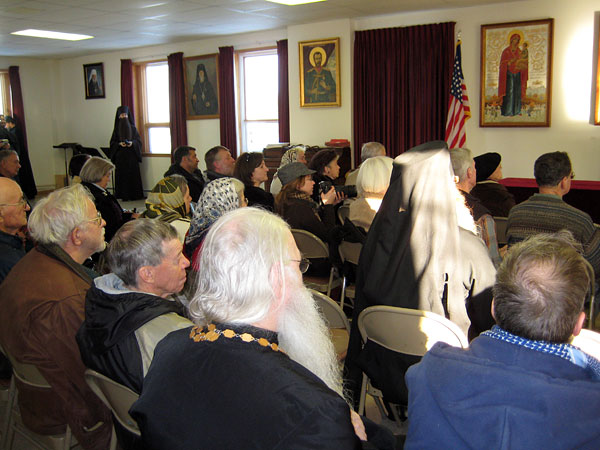 Since 1999, publicity surrounding the Seven to Save designation has led to the stabilization of St. Joseph’s Church in Albany, the rehabilitation of the Oswego City Public Library, and prevented the demolition of the Conger Goodyear House on Long Island, along with successes at several other locations.
Since 1999, publicity surrounding the Seven to Save designation has led to the stabilization of St. Joseph’s Church in Albany, the rehabilitation of the Oswego City Public Library, and prevented the demolition of the Conger Goodyear House on Long Island, along with successes at several other locations.
Five additional Seven to Save announcements will be made around the state in early 2008. Negotiations in December to determine whether NYRA would continue to run horse racing at the Belmont, Aqueduct and Saratoga tracks prompted the early designation of the historic Saratoga Race Course in Saratoga County last month.
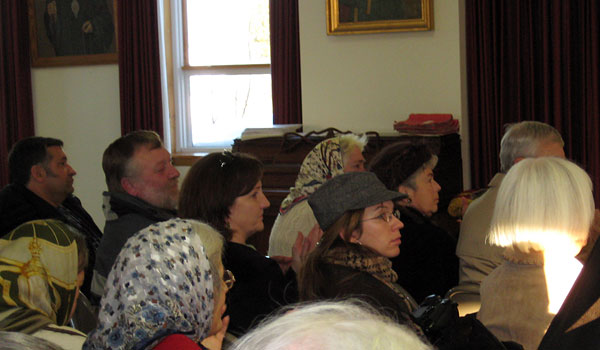 The Preservation League of New York State, founded in 1974, is a not-for-profit organization dedicated to the protection of New York’s diverse and rich heritage of historic buildings, districts and landscapes. From its headquarters in Albany, it provides a unified voice for historic preservation. By leading a statewide movement and sharing information and expertise, the Preservation League of New York State promotes historic preservation as a tool to revitalize the Empire State’s neighborhoods and communities.
The Preservation League of New York State, founded in 1974, is a not-for-profit organization dedicated to the protection of New York’s diverse and rich heritage of historic buildings, districts and landscapes. From its headquarters in Albany, it provides a unified voice for historic preservation. By leading a statewide movement and sharing information and expertise, the Preservation League of New York State promotes historic preservation as a tool to revitalize the Empire State’s neighborhoods and communities.
This press release was issued by the Preservation League of New York State, 44 Central Avenue, Albany NY 12206-3002, www.preservenys.org
 ALBANY, January 4, 2008 – The Preservation League of New York State has named the Holy Trinity Monastery in Jordanville, Herkimer County, to the nonprofit group’s annual list of the Empire State’s most threatened historic resources, Seven to Save. The campus of the Holy Trinity Monastery and Cathedral encompasses 750 acres of agricultural and scenic lands with multiple structures associated with the Holy Trinity Seminary, Convent of St. Elizabeth, and three cemeteries. Founded in 1928 as a refuge against religious persecution, it is the spiritual center of the Russian Orthodox Church Abroad. From the Monastery complex, panoramic views take in Monastery landmarks and places of prayer, while beyond the property boundaries are picturesque high plains. The views to the east are particularly significant in Orthodox scripture and faith.
ALBANY, January 4, 2008 – The Preservation League of New York State has named the Holy Trinity Monastery in Jordanville, Herkimer County, to the nonprofit group’s annual list of the Empire State’s most threatened historic resources, Seven to Save. The campus of the Holy Trinity Monastery and Cathedral encompasses 750 acres of agricultural and scenic lands with multiple structures associated with the Holy Trinity Seminary, Convent of St. Elizabeth, and three cemeteries. Founded in 1928 as a refuge against religious persecution, it is the spiritual center of the Russian Orthodox Church Abroad. From the Monastery complex, panoramic views take in Monastery landmarks and places of prayer, while beyond the property boundaries are picturesque high plains. The views to the east are particularly significant in Orthodox scripture and faith.




